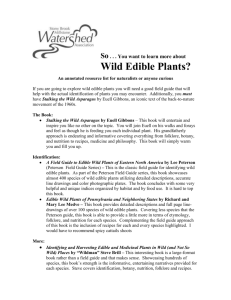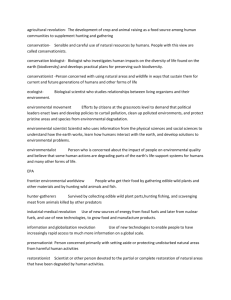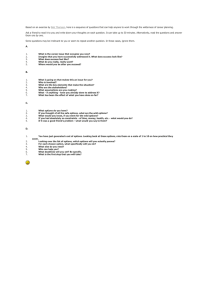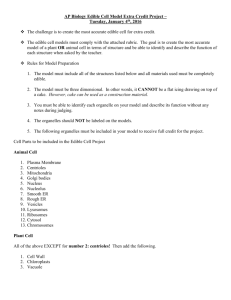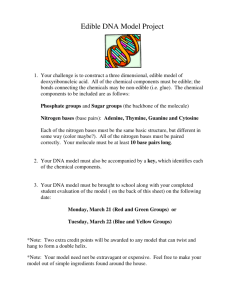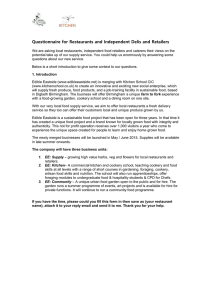Advance Journal of Food Science and Technology 6(11): 1272-1276, 2014
advertisement
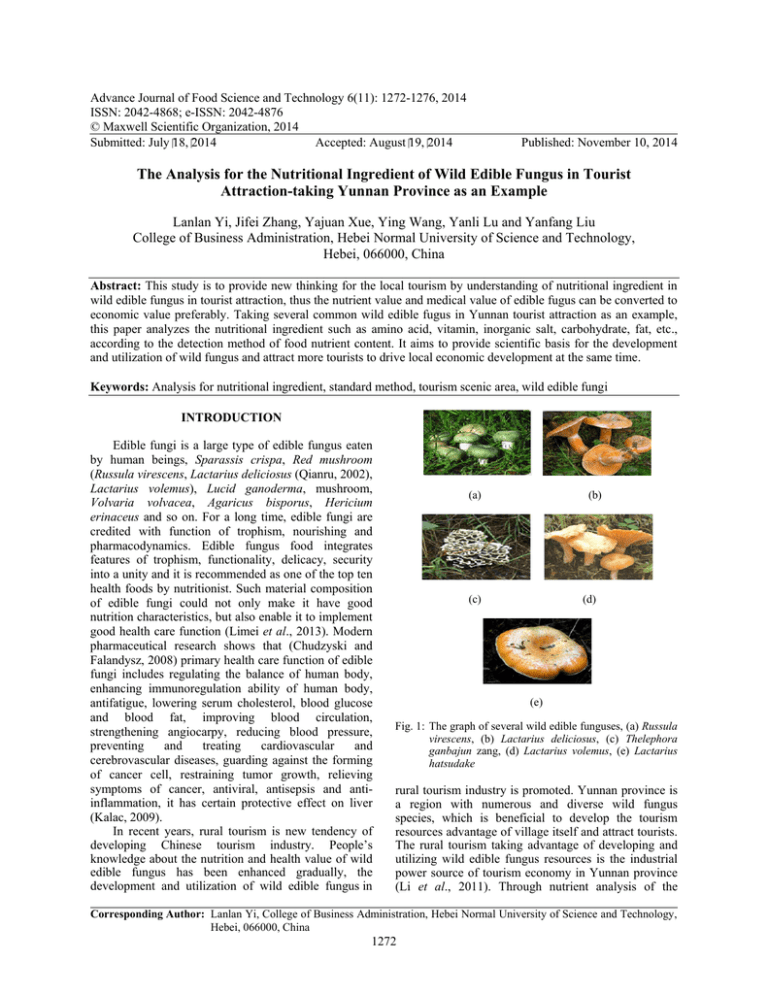
Advance Journal of Food Science and Technology 6(11): 1272-1276, 2014 ISSN: 2042-4868; e-ISSN: 2042-4876 © Maxwell Scientific Organization, 2014 Submitted: July 18, 2014 Accepted: August 19, 2014 Published: November 10, 2014 The Analysis for the Nutritional Ingredient of Wild Edible Fungus in Tourist Attraction-taking Yunnan Province as an Example Lanlan Yi, Jifei Zhang, Yajuan Xue, Ying Wang, Yanli Lu and Yanfang Liu College of Business Administration, Hebei Normal University of Science and Technology, Hebei, 066000, China Abstract: This study is to provide new thinking for the local tourism by understanding of nutritional ingredient in wild edible fungus in tourist attraction, thus the nutrient value and medical value of edible fugus can be converted to economic value preferably. Taking several common wild edible fugus in Yunnan tourist attraction as an example, this paper analyzes the nutritional ingredient such as amino acid, vitamin, inorganic salt, carbohydrate, fat, etc., according to the detection method of food nutrient content. It aims to provide scientific basis for the development and utilization of wild fungus and attract more tourists to drive local economic development at the same time. Keywords: Analysis for nutritional ingredient, standard method, tourism scenic area, wild edible fungi INTRODUCTION Edible fungi is a large type of edible fungus eaten by human beings, Sparassis crispa, Red mushroom (Russula virescens, Lactarius deliciosus (Qianru, 2002), Lactarius volemus), Lucid ganoderma, mushroom, Volvaria volvacea, Agaricus bisporus, Hericium erinaceus and so on. For a long time, edible fungi are credited with function of trophism, nourishing and pharmacodynamics. Edible fungus food integrates features of trophism, functionality, delicacy, security into a unity and it is recommended as one of the top ten health foods by nutritionist. Such material composition of edible fungi could not only make it have good nutrition characteristics, but also enable it to implement good health care function (Limei et al., 2013). Modern pharmaceutical research shows that (Chudzyski and Falandysz, 2008) primary health care function of edible fungi includes regulating the balance of human body, enhancing immunoregulation ability of human body, antifatigue, lowering serum cholesterol, blood glucose and blood fat, improving blood circulation, strengthening angiocarpy, reducing blood pressure, preventing and treating cardiovascular and cerebrovascular diseases, guarding against the forming of cancer cell, restraining tumor growth, relieving symptoms of cancer, antiviral, antisepsis and antiinflammation, it has certain protective effect on liver (Kalac, 2009). In recent years, rural tourism is new tendency of developing Chinese tourism industry. People’s knowledge about the nutrition and health value of wild edible fungus has been enhanced gradually, the development and utilization of wild edible fungus in (a) (b) (c) (d) (e) Fig. 1: The graph of several wild edible funguses, (a) Russula virescens, (b) Lactarius deliciosus, (c) Thelephora ganbajun zang, (d) Lactarius volemus, (e) Lactarius hatsudake rural tourism industry is promoted. Yunnan province is a region with numerous and diverse wild fungus species, which is beneficial to develop the tourism resources advantage of village itself and attract tourists. The rural tourism taking advantage of developing and utilizing wild edible fungus resources is the industrial power source of tourism economy in Yunnan province (Li et al., 2011). Through nutrient analysis of the Corresponding Author: Lanlan Yi, College of Business Administration, Hebei Normal University of Science and Technology, Hebei, 066000, China 1272 Adv. J. Food Sci. Technol., 6(11): 1272-1276, 2014 common wild edible fugus, this paper aims to provide basis for scientifically making use of the rich wild edible fugus resource in Yunnan, make tourists to better know the edible fugus, inspire their interests on picking and cook the edible fugus, strengthen the competitiveness of Yunnan tourism and push the development of local economy. Thus samples of fresh wild fungus should be selected to perform research in tourism scenic spots (Fig. 1). MATERIALS AND METHODS Material: Fresh samples of wild edible fungi: They are respectively picked from such tourism scenic spots as Kunming, Dali, Yimen county of Yuxi city, Anning, Chuxiong and so on in Yunnan province, where common and fresh wild edible fungus with large production and high economic value accounts for the largest proportion. Random sampling on that day is performed with corresponding method specified in ‘determination method of nutritional ingredient in food’ by professional staff, edible part is extracted according to the folk traditional method, weighed and calculated (Hongying, 2013). Then it is washed with distilled water for 3 times after being cleared up with tap water, its moisture would be air dried. A moderate amount of distilled water is added into all the material under test, then it is detected after full blending and beating with high-speed homogenate machine at the speed of 10000 r/min. V C Must be measured within 24 h, the sample with the other indicators could be preserved after being processed with the corresponding method stipulated in ‘determination method of nutritional ingredient in food’, the detection would be accomplished within 7 day (Yanping, 2009). Cook and process sample: The traditional cooking and processing samples in folk: fresh wild edible fungus is chopped into slices about 0.2 cm, 1600 W electric frying pan is used, a little golden dragon fish oil is added into the pan, oil temperature is about 125°C, stirfry with emergency fire is made for 2-3 min until it is done, then salt is added into it, a little water could be added into it in the process of frying. The sample of water canned: Fresh green mushroom fungus —> rinse —> blanching —> refrigeration —> overall canning —> adding soaking liquid —> vacuum seal is made through pumping —> autoclave sterilization (121°C×30 min). Method: Analysis is performed according to national standard method: Moisture-ordinary weighing method. pressure (105°C) -drying Protein-micro Kjeldahl method (N×6.25); fatSoxhlet extraction. DF (Dietary Fiber) -Neutral detergent method; ash content-burning weight method. Heat energy, carbohydrates-method of calculation. Inorganic element-ICP-AES method, seleniumdetermination method of fluorescence spectrophotometry. Vitamin-Carotene detection is made with paper chromatography, V PP is applied with microbiological method, V B1 , V B2 and V C is applied with fluorescence method. Amino acid-Hitachi 835-50 automatic amino acid analyzer is applied for detection after acid hydrolysis, colorimetry is used to detect after tryptophan being alkaline hydrolysis. Quality control standard-inorganic element uses GBW08551 pig liver powder, the other ingredient uses the standard milk powder provided by Nutrition and food research institute in China Academy of Preventive Medicine. Two parallel samples are made; the result takes the average value. Primary instrument: Plasma emission spectrograph such as inductive coupling and so on, Hitachi 835-50 automatic amino acid analyzer, 960 Fluorescence spectrophotometer instrument, autoclave. RESULT ANALYSIS The content of essential nutrient ingredient in wild edible fungus of Yunnan province (Table 1 and 2): We could know from Table 1 that there exists difference among the essential nutrient of different bacteria, but the difference is not big. The common point that they share is that all these bacteria have relative rich protein and dietary fiber. The protein content of fresh sample is 1.5-26.9%, the content of DF (Dietary Fiber) is 1.5-12.9%, which is higher than many market vegetables, where morel has the highest quantity of protein and dietary fiber. Through making analysis for the nutritional ingredient of several common bacteria, its content of thermal energy and fat is low, nutritional ingredient represents the characteristics of high quality protein, low-calorie and low fat. This is also the value of wild mushroom, which could also attract tourists to go shopping and make sightseeing tour on this scenic spot. Amino acid is the basic unit of protein composition (Jiang et al., 2009) and plays an important role in vital movement of human body. Amino acids can be divided into essential amino acids and non-essential amino acids, essential amino-acid could not be compounded by human beings, but originating from food supply. We could see from Table 2 that: 1273 Adv. J. Food Sci. Technol., 6(11): 1272-1276, 2014 Table 1: The content of essential nutrient ingredient in several wild edible fungus of Yunnan province (g/100 g) Nutritional ingredient Green mushroom Lactarius deliciosus Lactarius volemus Edible part/% edible/% 85.5 83.7 84.6 Moisture water 93.5 92.3 94.0 Thermal energy/kcal/% 16.0 20.0 14.0 Fat 0.1 0.2 0.4 Protein 2.6 2.2 1.4 Carbohydrate 0.8 2.0 0.9 Dietary fiber 2.3 3.0 2.5 Ash 0.9 0.6 0.8 Nutritional ingredient Thelephora ganbajun zang Boletus speciosus Boletus edulis Edible/% 85.6 91.0 93.0 Water 86.5 89.5 90.6 Thermal energy/kcal/% 17.0 32.0 29.0 Fat 0.4 0.3 0.4 Protein 3.7 4.2 4.0 Carbohydrate 2.1 3.0 3.2 Dietary fiber 6.3 2.2 1.5 Ash 1.3 0.8 0.9 Table 2: Amino acid content of several wild edible fungus in Yunnan province (mg/100 g) Amino acid Green mushroom Lactarius deliciosus Lactarius volemus Threonine 137 95 85 Valine 131 130 99 PHE 143 85 77 Methionine 90 38 17 Lysine 83 98 48 Leucine 166 224 206 Isoleucine 133 131 146 Tryptophan 36 30 17 Arginine 96 104 89 Glutamic acid 226 346 352 Histidine 75 64 23 Proline 130 80 23 Glycine 128 120 83 Aspartic acid 250 164 137 Serine 140 86 70 Tyrosine 169 85 33 Alanine 117 184 105 Cystine Essential amino acid 926 835 692 Sum 2251 2076 1610 Essential amino acid/total amino acid 0.41 0.41 0.43 Amino acid Thelephora ganbajun zang Boletus speciosus Boletus edulis Threonine 146 84 87 Valine 335 246 171 PHE (phenylalanine) 130 49 27 Methionine 33 16 7 Lysine 119 52 81 Leucine 527 129 40 Isoleucine 535 106 48 Tryptophan 38 30 Arginine 140 62 32 Glutamic acid 475 189 303 Histidine 41 57 59 Proline 60 68 81 Glycine 149 154 126 Aspartic acid 230 164 134 Serine 127 59 68 Tyrosine 78 26 31 Alanine 254 261 220 Cystine 86 144 Essential amino acid 1863 739 520 Sum 3417 1778 1659 Essential amino acid/total amino acid 0.55 0.42 0.32 • The variety of amino acids in these 8 fresh samples of wild edible fungus is relatively complete, each wild fresh bacterium contains 17 kinds of amino acids and boletus specious contains 18 amino acid. Except for delicious cow bacilli and tripe, all the other bacteria have rich essential amino acid of • 1274 Lactarius hatsudake 85.5 89.2 28.0 0.1 2.3 4.3 3.6 0.7 Morel 90.0 14.3 24.0 7.1 26.9 2.0 12.9 8.0 Fresh soybean 538 619 612 108 841 1122 601 142 920 2547 370 659 588 1701 734 490 611 201 4619 13403 0.35 Morel 96 117 75 29 116 248 86 175 306 36 69 94 174 78 53 111 21 819 1913 0.43 Whole egg 577 699 622 363 850 1046 629 222 736 1565 270 436 390 1155 867 492 649 245 5008 11807 0.42 human body. It indicates that most of the wild edible fungus could replenish the essential aminoacid for human body (Can et al., 2012). The content of essential amino-acid in protein is 32-55%, the constitution of amino acid in wild mushroom is obviously superior than composition Adv. J. Food Sci. Technol., 6(11): 1272-1276, 2014 Table 3: The content of inorganic element in several wild edible fungus of Yunnan province (mg/100 g) Inorganic Green Lactarius Lactarius Lactarius Dried Boletus element mushroom L. deliciosus volemus hatsudake mushroom speciosus K 265 217 249 205 32.80 295 Ca 3.90 7.10 4.00 3.10 10 4 P 53.00 69 26 50 104 58 Na 1.10 1.70 1.20 1.10 2.10 1.60 Mn 0.10 0.37 0.11 0.24 0.67 0.16 Mg 8.50 11.20 5.00 10.50 11.00 9 Fe 1.40 20.40 5.90 4.70 21.00 1.70 Cu 0.34 0.12 0.25 0.08 0.30 0.43 Zn 0.65 1.15 0.42 1.05 0.78 1.68 Se/ug 0.23 0.28 0.13 0.29 0.46 0.25 Boletus edulis 301 5 68 2.10 0.19 10 2.10 0.32 0.98 0.25 Table 4: The content of vitamin in 3 kinds of wild edible fungus belonging to red mushrooms type in Yunnan province (mg/100 g) Vitamin lactarius Volemus lactarius Deliciosus green Mushroom dried Mushroom boletus Speciosus boletus Riboflavin 0.46 0.75 0.60 1.84 0.14 Nicotinic acid 4.20 2.30 2.80 … 2.40 Thiamine 0.07 0.08 0.02 0.06 0.14 Vitamin E … 3.15 … 45.14 9.76 Ascorbic acid … … … … … Carotene … … … … … Table 5: The influence of traditional cooking and processing on the content of VB 1 and VB 2 VB 1 content (thiamin content) ------------------------------------------------------------------Name Before cooking After cooking Loss ratio/% Green mushroom 0.021 0.010 50.0 Lactarius volemus 0.070 0.041 42.8 Lactarius deliciosus 0.081 0.050 37.5 Boletus speciosus 0.140 0.112 21.4 Boletus edulis 0.140 0.081 42.9 Dried mushroom 0.036 0.035 90.1 • of beans (except for boletus edulis), it is almost close to the whole egg, the composition of Thelephora ganbajun zang is superior than whole egg. Thus, the protein of wild edible fungus belongs to fine protein. Aspartic acid and glutamic acid is flavor amino acid, all the 8 kinds of bacterium have rich aspartic acid and glutamic acid, its content is 19-26%, this is why it is delicious. The content of inorganic element in wild edible fungus of Yunnan province (Table 3): We could see from Table 3 that: the detection result of above 10 inorganic elements indicates that, 8 kinds of wild edible fungus have rich zinc (Zn), potassium and iron. The content of iron in Lactarius deliciosusm and dried mushroom is the highest; it is close to pork liver which has the richest iron, which is about dozens of times of iron content in general vegetable. There exists the highest difference in the content of copper, there exists more than 10 times the difference between highest and lowest content, in addition to that it has rich potassium the content of phosphorus and magnesium is also relatively high, the content of calcium is relatively low (3.0-10 mg/100 g), it is only the 1-10% of general colored vegetables, its content of sodium (Na) is relatively lower when compared to general vegetables (Kalac, 2010). The content of vitamin in wild edible fungus of Yunnan province (Table 4 and 5): We could see from Morel 44.50 0.80 56.90 0.58 0.04 0.62 0.84 0.03 0.12 0.02 Edulis 0.14 2.10 0.14 8.93 … … in fresh edible fungus (mg/100 g) VB 2 content (riboflavin content) -----------------------------------------------------------------Before cooking After cooking Loss ratio/% 0.451 0.282 35.5 0.561 0.401 28.6 0.750 0.410 49.3 0.990 0.451 54.5 1.110 1.021 8.1 1.592 1.260 75.1 Table 4 that: All the 8 kinds of bacterium has certain amount of thiamine and riboflavin, thiamine is called 𝑉𝑉𝐵𝐵1 , riboflavin is called 𝑉𝑉𝐵𝐵2 , its content is close to cabbage, celery and lean meat. 𝑉𝑉𝐵𝐵1 Participates in the catabolism of sugar in the form of coenzyme, it not only has the effect of protecting nerve, but also could promote the peristalsis of intestines and stomach. 𝑉𝑉𝐵𝐵2 Could prevent and cure cardiovascular disease and migraine, also have certain curative effect on some senile diseases. Dried mushroom has rich vitamin E, whose content is as high as 45.14 mg/100 g; vitamin E has the effect of oxidation resistance and delaying senescence. We could see from Table 5 that: All the several kinds of wild edible fungus have 𝑉𝑉𝐵𝐵1 and 𝑉𝑉𝐵𝐵2 . The content of 𝑉𝑉𝐵𝐵2 is the richest, it is the 14-28 times of that in tomatoes, 47-75 times of that in Benincasa hispida, it is a kind of superior food with 𝑉𝑉𝐵𝐵2 . However, cooking and processing would damage the content of 𝑉𝑉𝐵𝐵1 and 𝑉𝑉𝐵𝐵2 . Under this experimental condition, carotene and V C are detected among 8 kinds of red mushroom (Table 4), it represents that most of the wild edible fungus are in short of carotene and V C . DISCUSSION Through making analysis for the nutrition ingredient of several wild fungus in Yunnan province, the results indicate that there exists difference but not big among the variety of such nutrient substance as 1275 Adv. J. Food Sci. Technol., 6(11): 1272-1276, 2014 amino acids, inorganic elements, vitamin contained in different bacterial. Through making analysis for the results of 8 wild funguses, all of them have high content of protein and dietary fiber and the content of morel is the highest, but it does not have the required 8 kinds of amino acids in human body. As a whole, these fresh samples of 8 wild fungus have relatively comprehensive variety of amino acid, their nutrition ingredient is almost close to whole egg and has abundant fresh amino acid (glutamic acid and aspartic acid). In addition to that, through detecting the inorganic elements and vitamins, we could know that all these 8 kinds of wild fungus have abundant zinc, potassium, iron, 𝑉𝑉𝐵𝐵1 , 𝑉𝑉𝐵𝐵2 and the content of iron and 𝑉𝑉𝐵𝐵2 in dried mushroom is the most abundant. Through making analysis for the nutrition ingredient of 8 wild funguses in scenic spots in Yunnan province, it is estimated that most of the wild edible fungus have the characteristics of high quality protein, high iron, potassium, zinc, low sodium, fat and calories, which is beneficial to improve body protein, prevent obesity and high cholesterol. The study indicates that most of the wild edible funguses developed in Yunnan province are rich in nutrients, which could supplement essential nutrients, minerals, microelement of human body. Recently, iron and zinc are two of the essential elements that a Chinese person lacks. Thus, eating more edible fungus is good for absorbing iron, zinc and 𝑉𝑉𝐵𝐵2 . However, through experimental analysis, the content of some vitamin in edible fungus is extremely low and some vitamin would be destroyed during cooking. Thus, reasonable collocation and cooking methods should be taken care to make up for its nutrient deficiencies. Yunnan province has various variety of wild edible fungus, most of the recently developed wild fungus contains a lot of nutrient substance, such as amino acid, protein, vitamins and minerals and so on and they also have the effect of health care. As Yunnan province has various variety of wild edible fungus, it has attracted high-quality talent all over China to visit study and develop wild fungus in Yunnan province; in the meantime, it would attract people to study related knowledge about eating and cooking wild fungus in Yunnan, by which to drive the development of rural tourism industry in Yunnan province. REFERENCES Can, S., L. Jie, W. Yuping, L. Yang and X. Huakun, 2012. The content of amino acid in common wild edible fungus of Yunnan province. J. Mater. Class. Res., 34(1): 89-92. Chudzyski, K. and J. Falandysz, 2008. Multivariate analysis of elements content of Larch Bolete (Suillus grevillei) mushroom. Chemosphere, 73(8): 1230-1239. Hongying, M., 2013. The isolation, culture and identification of common edible fungi in Yunnan province. Yunnan, Yunnan University of Bio. Eng. Jiang, P.P., Y. Han and S.H. Gu, 2009. Detemination of amino acid in five edible fungi and heir nutrition evaluation. Amino Acids Biotic Resource, 31(2): 67-71. Kalac, C.P., 2009. Chemical composition and nutrition value of European species of wild growing mushrooms a review. Food Chem., 113(1): 9-16. Kalac, C.P., 2010. Trace element contents in European species of wild growing edible mushrooms: A review for the period 2000-2009. Food Chem., 122(1): 2-15. Li, T., Y.Z. Wang, J. Zhang, Y. Zhao and H. Liu, 2011. Trace element content of Boletus tomentipes mushroom collected from Yunnan, China. Food Chem., 127(2): 1828-1830. Limei, T., Z. Chunyan, G. Xiang, M. Ming and L. Bei, 2013. The development and application of several wild foods (drug) use bacteria resources in Yunan province. China's Edible Fungus, 32(2): 4-6. Qianru L., 2002. Research on nutrition assessment and fermentation technology of lactarius deliciosus. J. of Central South Forestry Univer. Yanping L., 2009. Studies on Extraction of Nutrients from Bashan Boletus edulis. J. of Xihua Univer. 1276
